Toyota Corolla Hybrid (2022 year). Manual in english — page 3
46
1-1. For safe use
Exhaust gas precau-
tions
Harmful substance to the
human body is included in
exhaust gases if inhaled.
WARNING
Exhaust gases include harmful
carbon monoxide (CO), which is
colorless and odorless. Observe
the following precautions.
Failure to do so may cause
exhaust gases enter the vehicle
and may lead to an accident
caused by light-headedness, or
may lead to death or a serious
health hazard.
■
Important points while driving
●
Keep the trunk lid closed.
●
If you smell exhaust gases in
the vehicle even when the trunk
lid is closed, open the windows
and have the vehicle inspected
at your Toyota dealer as soon
as possible.
■
When parking
●
If the vehicle is in a poorly venti-
lated area or a closed area,
such as a garage, stop the
hybrid system.
●
Do not leave the vehicle with
the hybrid system on for a long
time.
If such a situation cannot be
avoided, park the vehicle in an
open space and ensure that
exhaust fumes do not enter the
vehicle interior.
●
Do not leave the hybrid system
operating in an area with snow
build-up, or where it is snowing.
If snowbanks build up around
the vehicle while the hybrid sys-
tem is operating, exhaust gases
may collect and enter the vehi-
cle.
■
Exhaust pipe
The exhaust system needs to be
checked periodically. If there is a
hole or crack caused by corro-
sion, damage to a joint or abnor-
mal exhaust noise, be sure to
have the vehicle inspected and
repaired by your Toyota dealer.
47
1-2. Child safety
1
For safety and secu
rity
1-2.Child safety
Riding with children
Observe the following pre-
cautions when children are
in the vehicle.
Use a child restraint system
appropriate for the child,
until the child becomes
large enough to properly
wear the vehicle’s seat belt.
It is recommended that chil-
dren sit in the rear seats to
avoid accidental contact
with the shift lever, wiper
switch, etc.
Use the rear door child-pro-
tector lock or the window
lock switch to avoid children
opening the door while driv-
ing or operating the power
window accidentally.
(
Do not let small children
operate equipment which
may catch or pinch body
parts, such as the power
window, hood, trunk, seats,
etc.
WARNING
■
When children are in the vehi-
cle
Never leave children unattended
in the vehicle, and never allow
children to have or use the key.
Children may be able to start the
vehicle or shift the vehicle into
neutral. There is also a danger
that children may injure them-
selves by playing with the win-
dows or other features of the
vehicle. In addition, heat build-up
or extremely cold temperatures
inside the vehicle can be fatal to
children.
48
1-2. Child safety
Points to remember: P.48
Child restraint system: P.50
When using a child restraint sys-
tem: P.52
Child restraint system compati-
bility for each seating position
(for Puerto Rico): P.54
Child restraint system installa-
tion method
• Fixed with a seat belt: P.59
• Fixed with a child restraint
LATCH anchor (except for
Puerto Rico): P.64
• Fixed with an ISOFIX lower
anchorage (for Puerto Rico):
P.66
• Using an anchor bracket (for
top tether strap) (except for
Puerto Rico): P.68
• Using a top tether anchorage
(for Puerto Rico): P.70
The laws of all 50 states of the
U.S.A. as well as Canada now
require the use of child restraint
systems.
Prioritize and observe the
warnings, as well as the laws
and regulations for child
restraint systems.
Use a child restraint system
until the child becomes large
enough to properly wear the
vehicle’s seat belt.
Choose a child restraint sys-
tem that suits your vehicle
and is appropriate to the age
and size of the child.
Child restraint sys-
tems
Before installing a child
restraint system in the vehi-
cle, there are precautions
that need to be observed,
different types of child
restraint systems, as well as
installation methods, etc.,
written in this manual.
Use a child restraint system
when riding with a small child
that cannot properly use a
seat belt. For the child’s
safety, install the child
restraint system to a rear seat.
Be sure to follow the installa-
tion method that is in the oper-
ation manual enclosed with
the restraint system.
Table of contents
Points to remember
WARNING
■
When a child is riding
Observe the following precau-
tions.
Failure to do so may result in
death or serious injury.
49
1-2. Child safety
1
For safety and secu
rity
WARNING
●
For effective protection in auto-
mobile accidents and sudden
stops, a child must be properly
restrained, using a seat belt or
child restraint system which is
correctly installed. For installa-
tion details, refer to the opera-
tion manual enclosed with the
child restraint system. General
installation instruction is pro-
vided in this manual.
●
Toyota strongly urges the use of
a proper child restraint system
that conforms to the weight and
size of the child, installed on the
rear seat. According to accident
statistics, the child is safer when
properly restrained in the rear
seat than in the front seat.
●
Holding a child in your or some-
one else’s arms is not a substi-
tute for a child restraint system.
In an accident, the child can be
crushed against the windshield
or between the holder and the
interior of the vehicle.
■
Handling the child restraint
system
If the child restraint system is not
properly fixed in place, the child or
other passengers may be seri-
ously injured or even killed in the
event of sudden braking, sudden
swerving, or an accident.
●
If the vehicle were to receive a
strong impact from an accident,
etc., it is possible that the child
restraint system has damage
that is not readily visible. In
such cases, do not reuse the
restraint system.
●
For Puerto Rico: Depending on
the child restraint system, instal-
lation may be difficult or impos-
sible. In those cases, check
whether the child restraint sys-
tem is suitable for installment in
the vehicle. (
install and observe the usage
rules after carefully reading the
child restraint system fixing
method in this manual, as well
as the operation manual
enclosed with the child restraint
system.
●
Except for Puerto Rico: Make
sure you have complied with all
installation instructions provided
with the child restraint system
manufacturer and that the sys-
tem is properly secured.
●
Keep the child restraint system
properly secured on the seat
even if it is not in use. Do not
store the child restraint system
unsecured in the passenger
compartment.
●
If it is necessary to detach the
child restraint system, remove it
from the vehicle or store it
securely in the trunk.

50
1-2. Child safety
■
Types of child restraint system installation methods
Confirm with the operation manual enclosed with the child restraint
system about the installation of the child restraint system.
Child restraint system
Installation method
Page
Seat belt attachment

51
1-2. Child safety
1
For safety and secu
rity
Except for Puerto Rico:
Child restraint LATCH
anchors attachment
For Puerto Rico:
ISOFIX lower anchor-
age attachment
Except for Puerto Rico
For Puerto Rico
Installation method
Page

52
1-2. Child safety
■
When installing a child
restraint system to a front
passenger seat
For the safety of a child, install a
child restraint system to a rear
seat. When installing a child
restraint system to a front pas-
senger seat is unavoidable,
adjust the seat as follows and
install the child restraint system:
Move the front seat fully rear-
ward.
If the passenger seat height
can be adjusted, Adjust the
seat height to the upper most
position.
Adjust the seatback angle to
the most upright position.
If there is a gap between the child
seat and the seatback, adjust the
Except for Puerto Rico:
Anchor brackets (for
top tether strap) attach-
ment
For Puerto Rico:
Top tether anchorage
attachment
Seats with an adjustable type head
restraint:
Except for Puerto Rico
For Puerto Rico
Seats with an integrated type head
restraint:
Except for Puerto Rico
For Puerto Rico
Installation method
Page
When using a child
restraint system

53
1-2. Child safety
1
For safety and secu
rity
seatback angle until good contact is
achieved.
If the head restraint interferes
with the child restraint system
installation and the head
restraint can be removed,
remove the head restraint.
Otherwise, put the head restraint in
the upper most position.
WARNING
■
When using a child restraint
system
Observe the following precau-
tions.
Failure to do so may result in
death or serious injury.
●
Never install a rear-facing child
restraint system on the front
passenger seat even if the “AIR
BAG OFF” indicator light is illu-
minated. In the event of an acci-
dent, the force of the rapid
inflation of the front passenger
airbag can cause death or seri-
ous injury to the child if the
rear-facing child restraint sys-
tem is installed on the front pas-
senger seat.
●
A forward-facing child restraint
system may be installed on the
front passenger seat only when
it is unavoidable. A child
restraint system that requires a
top tether strap should not be
used in the front passenger seat
since there is no top tether strap
anchor for the front passenger
seat.
●
A forward-facing child restraint
system may be installed on the
front passenger seat only when
it is unavoidable. When install-
ing a forward-facing child
restraint system on the front
passenger seat, adjust the seat-
back angle to the most upright
position, move the seat to the
rearmost position, and raise the
seat to the upper most position,
even if the “AIR BAG OFF” indi-
cator light is illuminated. If the
head restraint interferes with the
child restraint system installa-
tion and the head restraint can
be removed, remove the head
restraint.
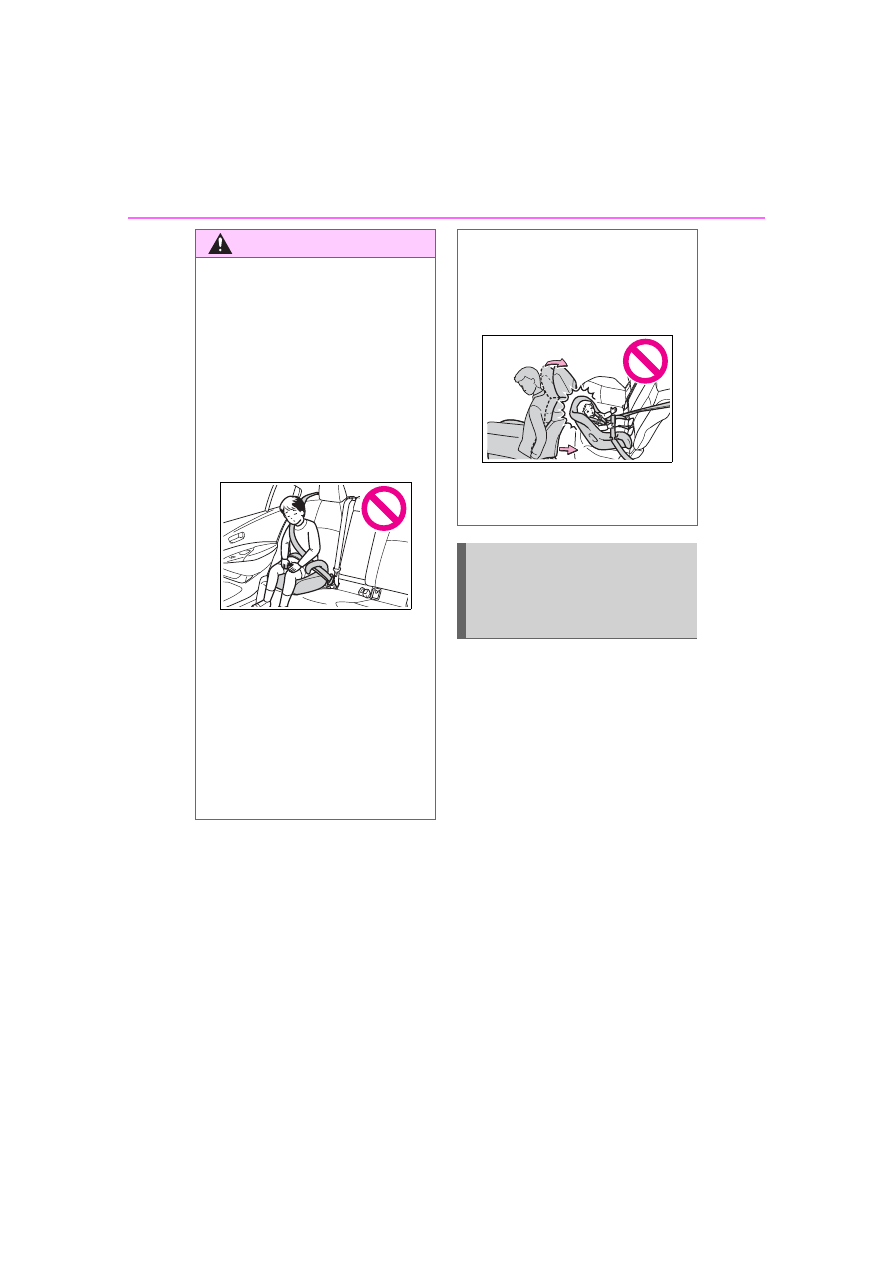
54
1-2. Child safety
■
Child restraint system com-
patibility for each seating
position
Compatibility of each seating
position with child restraint sys-
tems (
P.56) displays the type
of child restraint systems that
can be used and possible seat-
ing positions for installation
using symbols.
Also, the recommended child
restraint system that is suitable
for your child can be selected.
Otherwise, check [Recom-
mended child restraint systems
and Compatibility table] for rec-
ommended child restraint sys-
tems. (
P.58)
Check the selected child
WARNING
●
Do not allow the child to lean
his/her head or any part of
his/her body against the door or
the area of the seat, front or rear
pillars, or roof side rails from
which the SRS side airbags or
SRS curtain shield airbags
deploy even if the child is
seated in the child restraint sys-
tem. It is dangerous if the SRS
side and curtain shield airbags
inflate, and the impact could
cause death or serious injury to
the child.
●
When a booster seat is
installed, always ensure that the
shoulder belt is positioned
across the center of the child’s
shoulder. The belt should be
kept away from the child’s neck,
but not so that it could fall off the
child’s shoulder.
●
Use child restraint system suit-
able to the age and size of the
child and install it to the rear
seat.
●
If the driver’s seat interferes
with the child restraint system
and prevents it from being
attached correctly, attach the
child restraint system to the
right-hand rear seat.
●
Adjust the front passenger seat
so that it does not interfere with
the child restraint system.
Child restraint system
compatibility for each
seating position (for
Puerto Rico)

55
1-2. Child safety
1
For safety and secu
rity
restraint system together with
the following [Before confirming
the compatibility of each seating
position with child restraint sys-
tems].
■
Before confirming the com-
patibility of each seating
position with child restraint
systems
1
Checking the child restraint
system standards.
Use a child restraint system
that conforms to UN(ECE)
R44
*1
or UN(ECE) R129
*1, 2
.
The following approval mark
is displayed on child restraint
systems which are con-
formed.
Check for an approval mark
attached to the child restraint
system.
Example of the displayed regulation
number
UN(ECE) R44 approval
mark
*3
The weight range of the child
who is applicable for an
UN(ECE) R44 approval mark
is indicated.
UN(ECE) R129 approval
mark
*3
The height range of the child
who is applicable as well as
available weights for an
UN(ECE) R129 approval
mark is indicated.
2
Checking the category of the
child restraint system.
Check the approval mark of
the child restraint system for
which of the following catego-
ries the child restraint system
is suitable.
Also, if there are any uncer-
tainties, check the user’s
guide included with the child
restraint system or contact
the retailer of the child
restraint system.
• “universal”
• “semi-universal”
• “restricted”
• “vehicle specific”
*1
:UN(ECE) R44 and UN(ECE)
R129 are U.N. regulations for
child restraint systems.
*2
:The child restraint systems men-
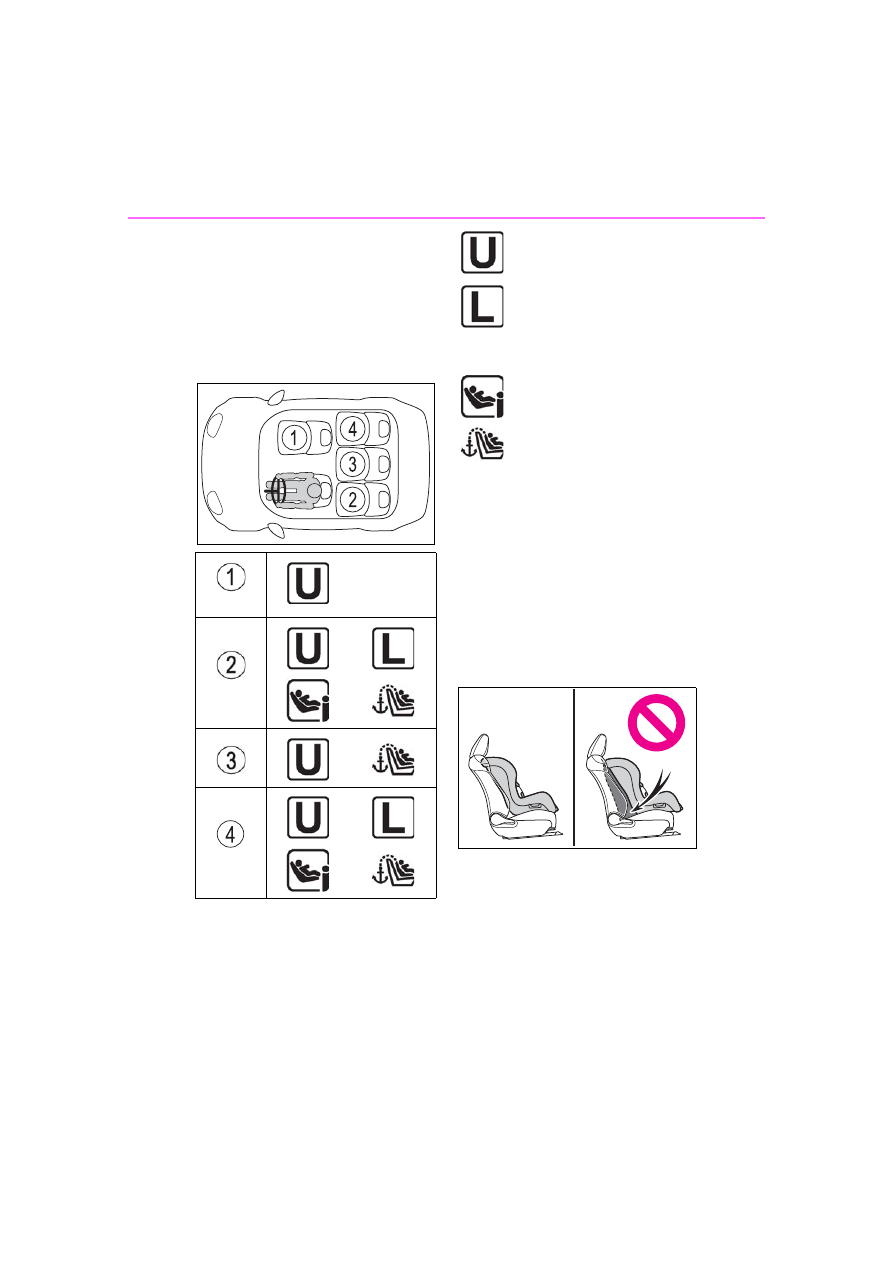
56
1-2. Child safety
tioned in the table may not be
available outside of the EU area.
*3
:The displayed mark may differ
depending on the product.
■
Compatibility of each seat-
ing position with child
restraint systems
*1
:Move the front seat fully rear-
ward. If the passenger seat
height can be adjusted, move it
to the upper most position.
*2
:Adjust the seatback angle to the
most upright position. When
installing a forward-facing child
seat, if there is a gap between
the child seat and the seatback,
adjust the seatback angle until
good contact is achieved.
*3
:If the head restraint interferes
with your child restraint system,
and the head restraint can be
removed, remove the head
restraint.
Otherwise, put the head restraint
in the upper most position.
*1, 2, 3
*3
*3
Suitable for “universal” cate-
gory child restraint system
fixed with the seat belt.
Suitable for child restraint
systems given on recom-
mended child restraint sys-
tems and compatibility table
(
Suitable for i-Size and ISO-
FIX child restraint system.
Includes a top tether anchor-
age point.
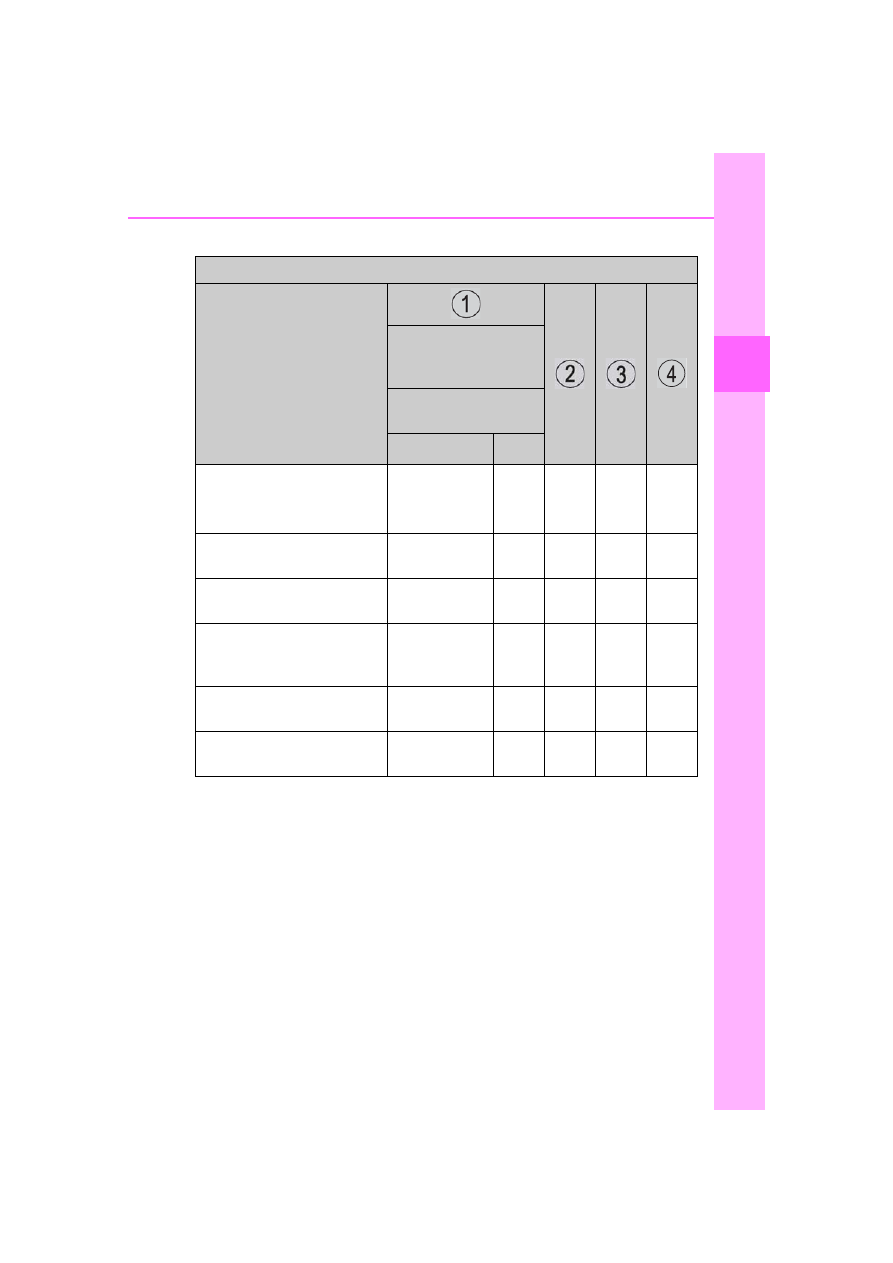
57
1-2. Child safety
1
For safety and secu
rity
■
Detail information for child restraint systems installation
*
: When it is unavoidable to install a rear-facing child restraint system on the
front passenger seat, a child restraint system can be installed it the PAS-
SENGER AIR BAG OFF indicator lamp is lit.
ISOFIX child restraint systems are divided into different “fixture”. The
child restraint system can be used in the seating positions for “fix-
ture” mentioned in the table above. For kind of “fixture” relation, con-
firm the following table.
If your child restraint system has no kind of “fixture” (or if you cannot
find information in the table below), please refer to the child restraint
system “vehicle list” for compatibility information or ask the retailer of
your child seat.
Seating position
Seat position number
Vehicle with front pas-
senger occupant
detection system
Passenger airbag indi-
cator light
ON
OFF
*
Seating position suitable for
universal belted (Yes/No)
Yes
Forward fac-
ing only
Yes
Yes
Yes
Yes
i-Size seating position
(Yes/No)
No
No
Yes
No
Yes
Seating position suitable for
lateral fixture (L1/L2/No)
No
No
No
No
No
Suitable rearward facing fix-
ture (R1/R2X/R2/R3/No)
No
No
R1,
R2X,
R2
No
R1,
R2X,
R2
Suitable forward facing fix-
ture (F2X/F2/F3/No)
No
No
F2X,
F2, F3
No
F2X,
F2, F3
Suitable junior seat fixture
(B2/B3/No)
No
No
B2, B3
No
B2, B3

58
1-2. Child safety
■
Recommended child restraint systems and Compatibility
table
*
: When it is unavoidable to install a rear-facing child restraint system on the
front passenger seat, a child restraint system can be installed it the PAS-
SENGER AIR BAG OFF indicator lamp is lit.
The child restraint systems mentioned in the table may not be avail-
Fixture
Description
F3
Full-height, forward-facing child restraint systems
F2
Reduced-height forward-facing child restraint systems
F2X
Reduced-height forward-facing child restraint systems
R3
Full-size, rearward-facing child restraint systems
R2
Reduced-size, rearward-facing child restraint systems
R2X
Reduced-size, rearward-facing child restraint systems
R1
Rearward-facing infant seat
L1
Left lateral-facing (carrycot) infant seat
L2
Right lateral-facing (carrycot) infant seat
B2
Junior seat
B3
Junior seat
Mass groups
Recom-
mended
Child
Restraint
System
Seating position
Vehicle with front pas-
senger occupant
detection system
Passenger airbag indi-
cator light
ON
OFF
*
0, 0+
Up to 28 lb.
(13 kg)
MIDI 2
(Yes/No)
No
No
Yes
No
Yes
I
20 to 39 lb.
(9 to 18 kg)
MIDI 2
(Yes/No)
No
No
Yes
No
Yes
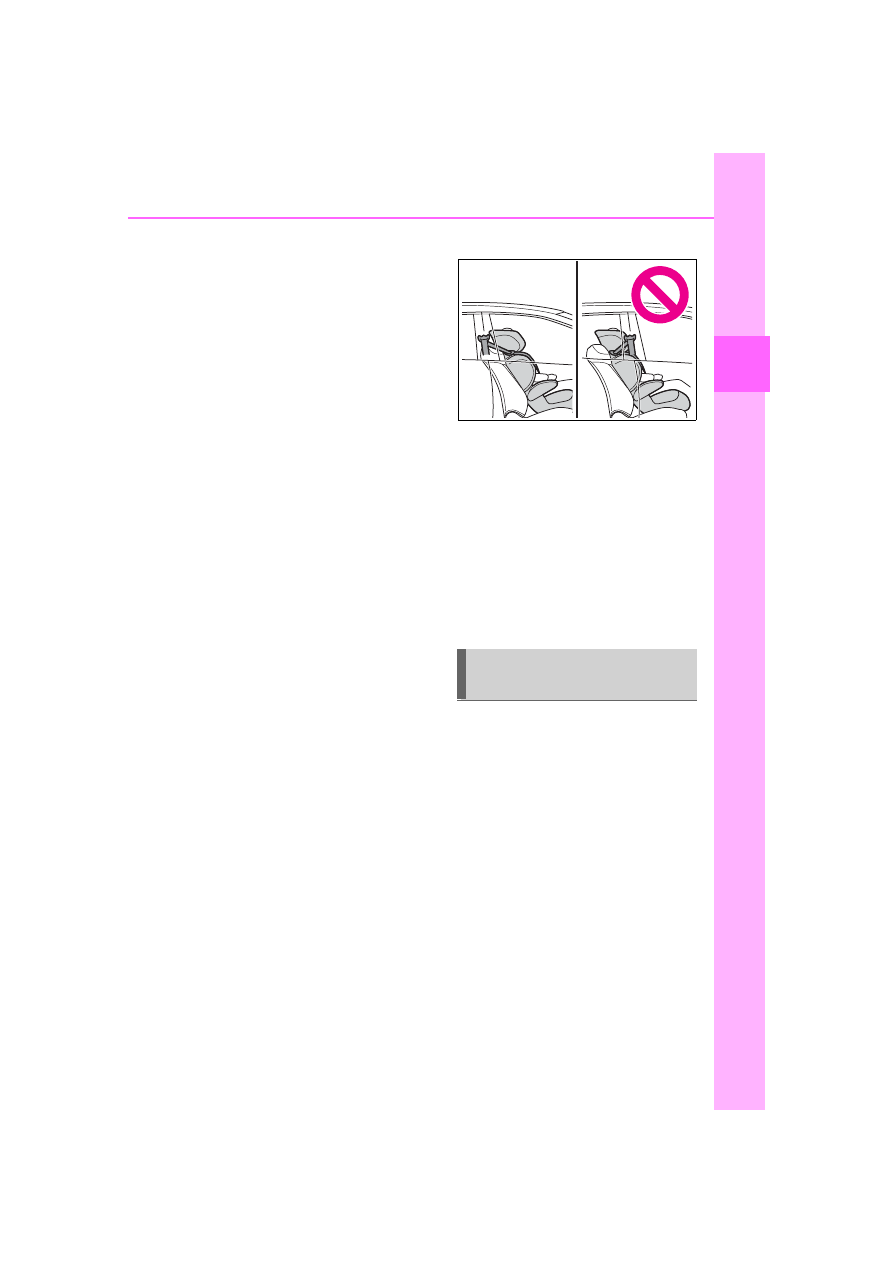
59
1-2. Child safety
1
For safety and secu
rity
able outside the LATIN area.
When securing some types of
child restraint systems in rear
seat, it may not be possible to
properly use the seat belts in
positions next to the child
restraint without interfering with
it or affecting seat belt effective-
ness. Be sure your seat belt fits
snugly across your shoulder and
low on your hips. If it does not,
or if it interferes with the child
restraint, move to a different
position. Failure to do so may
result in death or serious injury.
When installing a child
restraint in the rear seats,
adjust the front seat so that it
does not interfere with the
child or child restraint system.
When installing a child seat
with support base, if the child
seat interferes with the seat-
back when latching it into the
support base, adjust the seat-
back rearward until there is no
interference.
If the seat belt shoulder
anchor is ahead of the child
seat belt guide, move the seat
cushion forward.
When installing a junior seat,
if the child in your child
restraint system is in a very
upright position, adjust the
seatback angle to the most
comfortable position. And if
the seat belt shoulder anchor
is ahead of the child seat belt
guide, move the seat cushion
forward.
A child restraint system for a
small child or baby must itself be
properly restrained on the seat
with the lap portion of the
lap/shoulder belt.
■
Installing child restraint
system using a seat belt
(child restraint lock func-
tion belt)
Install the child restraint system
in accordance to the operation
manual enclosed with the child
restraint system.
For Puerto Rico: If the child
restraint system on hand is not
within the “universal” category
Child restraint system
fixed with a seat belt

60
1-2. Child safety
(or the necessary information is
not in the table), refer to the
“Vehicle List” provided by the
child restraint system maker for
various possible installation
positions, or check the compati-
bility after asking the retailer of
the child seat. (
■
Rear-facing
Infant
seat/convertible seat
1
Place the child restraint sys-
tem on the rear seat facing
the rear of the vehicle.
2
Run the seat belt through the
child restraint system and
insert the plate into the
buckle. Make sure that the
belt is not twisted.
3
Fully extend the shoulder belt
and allow it to retract to put it
in lock mode. In lock mode,
the belt cannot be extended.
4
While pushing the child
restraint system down into
the rear seat, allow the shoul-
der belt to retract until the
child restraint system is
securely in place.
After the shoulder belt has
retracted to a point where there is
no slack in the belt, pull the belt to
check that it cannot be extended.
5
After installing the child
restraint system, rock it back
and forth to ensure that it is
installed securely. (
■
Forward-facing
Convert-
ible seat
1
If installing the child restraint
system to the front passen-
ger seat is unavoidable, refer
to P.52for the front passenger
seat adjustment.
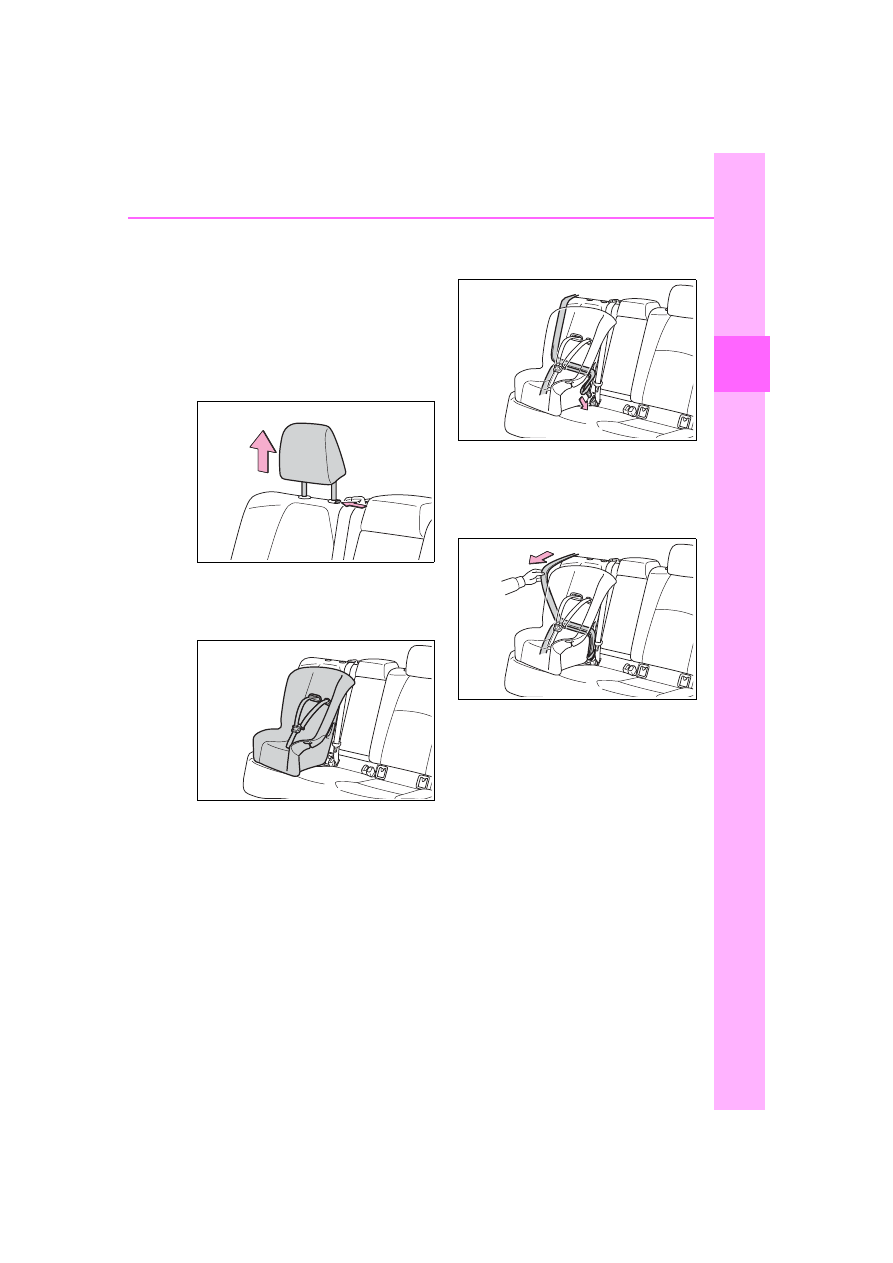
61
1-2. Child safety
1
For safety and secu
rity
2
If the head restraint interferes
with your child restraint sys-
tem, and the head restraint
can be removed, remove the
head restraint.
Otherwise, put the head
restraint in the upper most
position. (
3
Place the child restraint sys-
tem on the seat facing the
front of the vehicle.
4
Run the seat belt through the
child restraint system and
insert the plate into the
buckle. Make sure that the
belt is not twisted.
5
Fully extend the shoulder belt
and allow it to retract to put it
in lock mode. In lock mode,
the belt cannot be extended.
6
While pushing the child
restraint system into the rear
seat, allow the shoulder belt
to retract until the child
restraint system is securely in
place.
After the shoulder belt has
retracted to a point where there is
no slack in the belt, pull the belt to

Нет комментариевНе стесняйтесь поделиться с нами вашим ценным мнением.
Текст